Written by Erik Sofge
For millions of Americans living along the Gulf and Atlantic coastlines, hurricane season is an annual call to arms, a six-month stretch from June through November spent watching the skies and the local news for signs of trouble. Other regions cope with the threat of wildfires, quakes and tornadoes-and blackouts can strike anywhere. While no season is safe from disruption, late summer seems particularly inviting to the demons of disaster. Here’s a step-by-step guide to preparing your home and family.
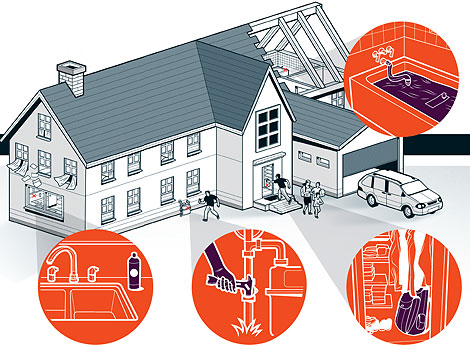
(Illustration by Gabriel Silveira)
 Power
Power

Honda EU 3000iSA 2800 watt generator
A properly equipped homeowner can survive without electricity. But having a backup generator can make the experience a lot more tolerable-if you have the know-how to use it correctly.
• Do the Math
Add up the wattage of all the devices you want to run off the generator, as well as the total surge wattage (the spike in power demand caused by some high-wattage appliances), and buy a generator whose output can handle those totals. For example, the 2800-watt (3000 surge watts) Honda EU 3000iSA ($2000) should provide enough power to light seven 60-watt bulbs (420 watts), a full-size refrigerator (725 watts, 1600 surge watts), a fan (200 watts) and a microwave (750 watts). If you think you’ll need more power, buy a larger generator.
• Keep it Outside
Carbon-monoxide-spewing generators can turn your house into a deathtrap. Always position a generator at least 10 feet from the house in an unenclosed space before turning it on.
• Know When to Call the Pros
Improperly plugging a generator into your home wiring is dangerous. For a full-scale power supply, hire an electrician to install a transfer switch, or buy a permanent backup generator system.
 Safety
Safety
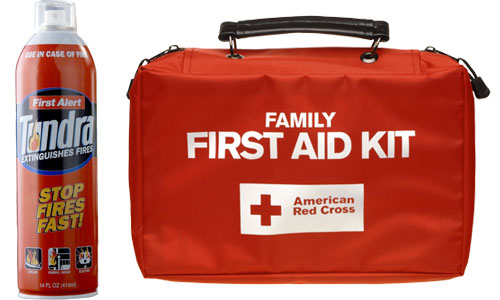
First Alert Tundra extinguisher and Red Cross Family First Aid Kit
Larger fire extinguishers with higher UL ratings can tackle more surface area. At the minimalist end of the spectrum, the 9.65-inch-long, 22-ounce First Alert Tundra extinguisher ($30) is compact and light enough to fit into a box of disaster supplies or a drawer, and is powerful enough to handle small flare-ups.
First-aid kits also come in a variety of sizes, but the Red Cross Family First Aid Kit ($20) stocks more than enough supplies to treat minor cuts and burns.
 Communication
Communication
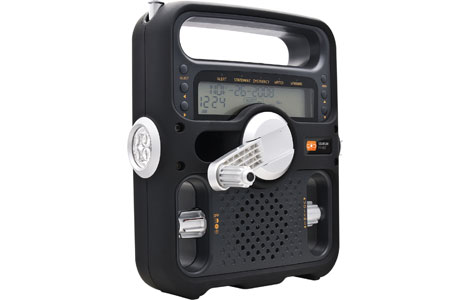
Eton FR600 Solarlink radio
If the power goes out, so does the Weather Channel. An NOAA radio provides constant weather alerts from the National Weather Service. Simple hand-cranked models cost as little as $30, but for long-term emergencies, Eton’s FR600 Solarlink ($80) is a better choice. It can also run on sunlight, has built-in LED lights and can be used to charge cellphones. And make sure everybody’s wallet has a printed list of family contact information, including a point person at least 50 miles away who can coordinate communication in case local telecommunications are down.
 Evacuation
Evacuation
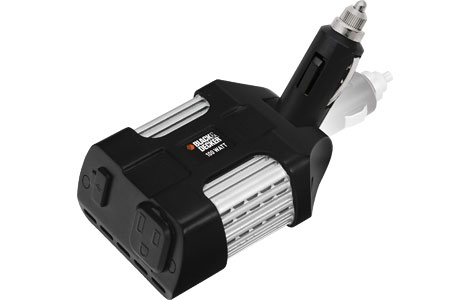
Black & Decker 100 Watt Power Inverter
Your home may be a fortress, but it doesn’t have to be the Alamo. Knowing how to retreat is a key component of disaster preparedness.
• Grab a Bag
If a quick getaway is called for, you won’t have time to pack. Prepare a bag with essential supplies, and keep it by your front door. It should include: a prepaid phone card, matches (either waterproof or in a waterproof container), a flashlight, an NOAA radio, batteries, food, an emergency whistle, extra keys for your home and car, prescription medications, a first-aid kit, $300 in small denominations and diapers and formula or other necessities for any children.
• Bring Your Paperwork
Prepack the following documents in a sealed Ziploc bag, and keep it stashed in your grab-and-go bag: bank records, copies of deeds, insurance policies, personal identification and medical records.
• Get in the Car
If a disaster is coming, fill up your gas tank. A power inverter allows you to use AC plugs in your cigarette-lighter jack. A 100-watt model such as the Black & Decker 100 Watt Power Inverter ($30) should do.
 Water
Water
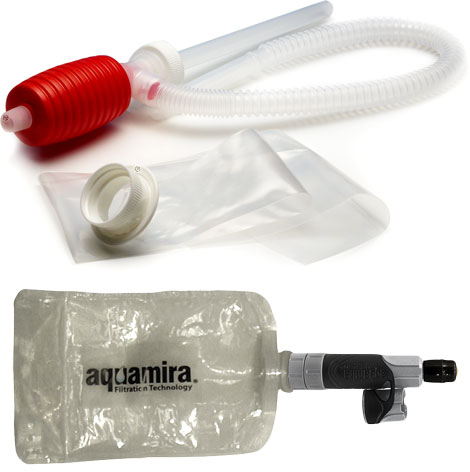
WaterBOB (top) and Aquamira Frontier Pro
You’ll need a gallon of clean drinking water per person, per day. If you’re expecting a long haul, load up the WaterBOB ($30). This bathtub-filling bladder hooks up to your faucet and holds up to 100 gallons of water, in case the local water supply is compromised. You can also keep a backup filter on hand-the Aquamira Frontier Pro ($25) acts like a germ-killing straw, eliminating bacteria in up to 50 gallons of water. A special adaptor lets you attach the filter to a water heater, which holds as much as 30 gallons of additional water.
![]()
Shutting Down Your House
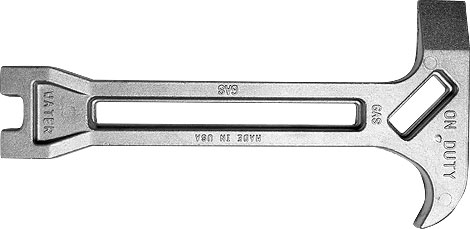
On Duty 4-in-1 Emergency Tool
If heavy flooding is imminent, turning off your electricity and water-to avoid contamination as sewers and other systems overflow, and to prevent a submerged basement from becoming electrified-is a risk-reducing procedure. Natural gas, on the other hand, should only be shut off when authorities advise it. Although a simple wrench or pliers will adjust most gas and water valves, the On Duty 4-in-1 Emergency Tool ($17) is designed to quickly handle both. If you do turn off the gas, never turn it back on yourself-your utility company has a better chance of spotting damaged lines.
Good thing someone is thinking about these sorts of things. Of course, if you’re not prepared, just find your closest Mormon neighbor. They’ll have all this stuff, plus food to last awhile.
light seven 60-watt bulb
use led:) it’s about 5 watt or aren’t they that advanced in US?
you´re not truly prepared to the apocalypse if dont have a shotgun (y)
I agree with Sam. That’s why I wouldn’t brag to others about being prepared…
People who survived on their roofs during Katrina actually said they planned to keep a loaded shotgun in their attics to prepare for any future storms and flooding. Much easier to blow a hole in the roof that hack your way out, even with an ax.
This seems a LOT like part of a chapter in the Zombie Survival Guide by Max Brooks.
Just sayin’.